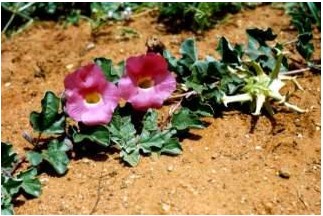Product Description
Harpagophytum procumbens (Burch.) DC ex Meisn. subsp. procumbens and subsp. transvaalense Ihlenf. & H.E.K Hartmann
Family: Pedaliaceae
Common names: devil’s claw, harpago, grapple plant, wool- and woodspider (Eng.); duivelsklou, bobbejaandubbeltjie, kloudoring, veldspinnakop (Afr.); teufelskralle, trampelklette (German); sengaparile, kanako, lekgagamare, ghamaghoe (Setswana); //x’aatataba, tloutaxaba (San), otjihangatene (Herero)
Tread with care where Harpagophytum procumbens, or devil’s claw, is lurking. It has nasty, spiny fruits but it is one of the chief medicinal plants southern Africa has given to the world. Its uses are multifarious and many tons of dried tubers are exported each year, mainly to Europe. Most of this is harvested in the wild so there has been much concern about over-harvesting. Efforts to get the plant into cultivation have not yet led to much success.
Description
Devil’s claw is a prostrate, sprawling plant with a stout, perennial rootstock that has a group of secondary storage tubers arising from it. Trailing annual stems bear opposite leaves. These are irregularly 3-5-lobed and greyish green because they are covered in tiny whitish mucilage cells.
Uses
Devil’s claw has long been known as a medicinal plant, with the San of the Kalahari having used it first, many generations ago. A German, G.H. Mehnert, learnt about this plant from the San and Nama people in Namibia and let it be known in 1904. It was exported to Germany first, and a small industry developed, based on material mainly from Namibia and Botswana. World demand has risen a lot since 1962 and especially in this century. Namibia has exported 2000 t. of dried roots in a year that may have involved up to 50 million plants.
The harvesters, of whom there are thousands, are almost all from very poor, rural communities living in near-desert conditions. They are mostly women, between 40 and 60 years old, who have little if any means of making a living and hence turn to harvesting devil’s claw. This is despite the poor rewards for long hours and long distances travelled on foot.
Devil’s claw is a veritable cure-all, but only whole extracts have the therapeutic effect, not isolated parts. The most important components are iridoid glycosides (mainly harpagoside, harpagide and procumbide). Some of its properties are listed: analgesic, anti-arrhythmic, antibacterial, anti-inflammatory, antirheumatic, diuretic, hypotensive, laxative, purgative, sedative, uterocontractant and a febrifuge, cholelogue and bitter tonic. In western medicine it is mainly used for arthritis and rheumatism. It apparently works like cortisone but without the bad side effects of that drug. In its local areas, and increasingly elsewhere, it has also been used for fever, blood diseases, blood purification, lower back pain and pain in pregnant women, coughs, diarrhoea, diabetes, bleeding gums, syphilis, gonorrhoea, gout and lumbago. It also helps with diseases of the liver, gall bladder, kidneys, pancreas, digestive system (heartburn, peptic ulcers, constipation and lack of appetite) and small joints, as well as hypertension, high cholestrol and tuberculosis. Externally it helps heal ulcers, boils, skin lesions and wounds (Neuwinger 2000; Powell 2001).
There are some contradictions and warnings in the literature ( such as in Duke et al . 2002). Devil’s claw can be allergenic and is contra-indicated for diabetics and people with duodenal and gastric ulcers. Very high doses may act against blood pressure and cardiac therapy. Von Koenen (2001) reports that many local people consider that Europeans use this herb too strongly and damage may result. He noted that if the tea is drunk too strong and too often, cancer, kidney damage or arthritis might be caused. High doses may also cause abortion.
